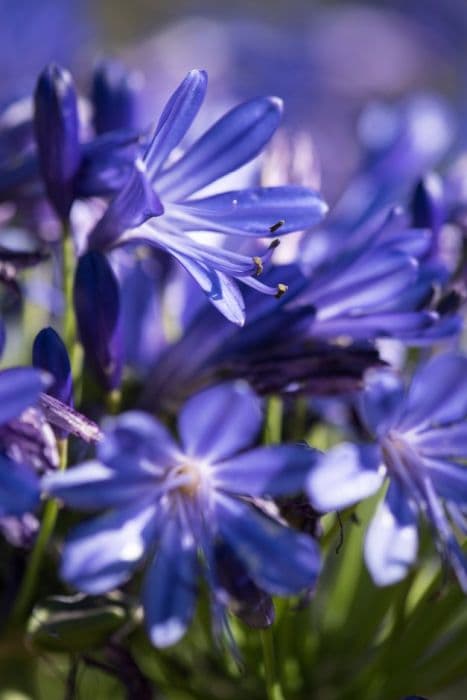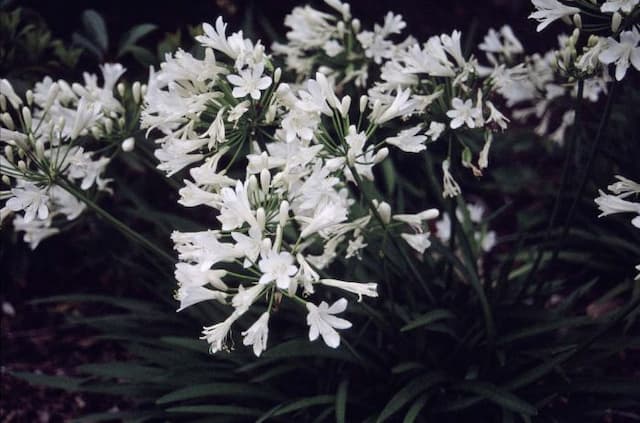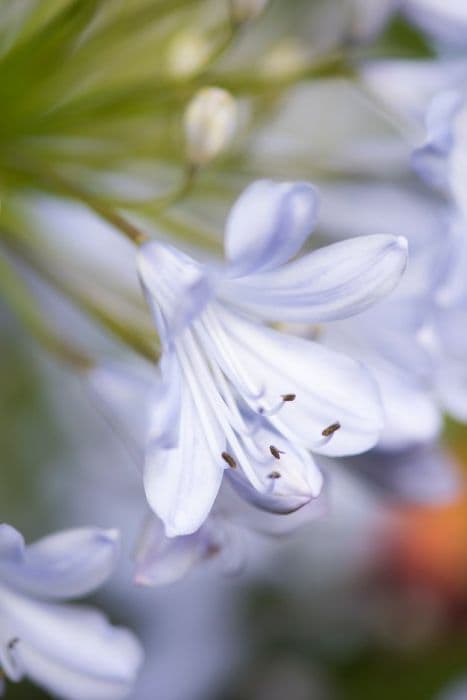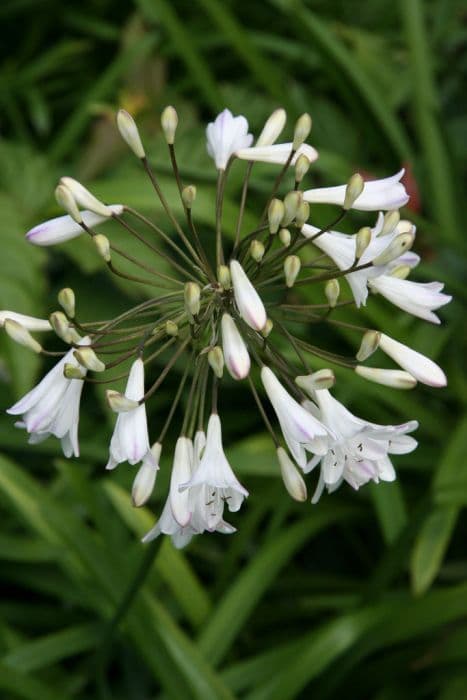African Lily Agapanthus 'Donau'

ABOUT
The Agapanthus 'Donau', commonly known as the African Lily or Lily of the Nile, is a striking plant characterized by its lush, strap-like green leaves that form a dense clump at the base. This foliage provides a verdant backdrop for the plant's most notable feature: its beautiful flowers. The African Lily produces rounded clusters of trumpet-shaped blooms, which are perched atop sturdy, erect stems that rise gracefully above the foliage. These flowers are typically a captivating shade of blue, ranging from a soft, sky blue to a deeper cobalt, and they often display a gradient of hues within each petal. The blooms are densely packed within each spherical cluster, creating a rich and full appearance that can be quite eye-catching in the garden. The overall impression is one of elegant simplicity and vibrant color, making the African Lily a popular choice for ornamental purposes.
About this plant
 Names
NamesFamily
Amaryllidaceae
Synonyms
African Lily, Lily of the Nile, Love Flower
Common names
Unfortunately, there are no synonyms for Agapanthus 'Donau'; it is a uniquely named cultivar. The basic scientific name provided, Agapanthus 'Donau', is the only name for this particular plant.
 Toxicity
ToxicityTo humans
The African Lily, also known as Agapanthus 'Donau', contains compounds that can be toxic to humans if ingested. While it primarily poses a risk to pets, it can still cause harm to humans. Symptoms of poisoning from the African Lily may include nausea, vomiting, and diarrhea. In some cases, severe ingestion can lead to dizziness, tremors, and cardiac problems. It is important to be cautious and avoid ingesting any part of this plant.
To pets
The African Lily, also known as Agapanthus 'Donau', is poisonous to pets, especially cats and dogs. Ingesting any part of the plant can result in symptoms such as vomiting, diarrhea, abdominal pain, and sometimes excessive salivation. In more severe cases, ingestion can cause lethargy, tremors, or even heart problems. Owners should keep their pets away from this plant and seek veterinary attention immediately if ingestion is suspected.
 Characteristics
CharacteristicsLife cycle
Perennials
Foliage type
Evergreen
Color of leaves
Green
Flower color
Blue
Height
2 feet (60 cm)
Spread
2 feet (60 cm)
Plant type
Bulb
Hardiness zones
8
Native area
South Africa
Benefits
 General Benefits
General Benefits- Low Maintenance: Agapanthus 'Donau' is relatively easy to care for, requiring minimal pruning and upkeep.
- Drought Tolerance: Once established, it has a good tolerance for drought, making it suitable for dry climate gardens.
- Ornamental Appeal: With its striking blue flowers, it provides a visual highlight in garden beds and borders.
- Attracts Pollinators: The flowers of the Lily of the Nile attract bees, butterflies, and other beneficial insects.
- Long Blooming Period: This plant typically has a long flowering season, offering color and interest for much of the summer.
- Versatility in Landscaping: It can be used in a variety of garden designs, including rock gardens, coastal gardens, and as container plants.
- Erosion Control: The fibrous roots can help stabilize soil, thus controlling erosion on slopes and banks.
 Medical Properties
Medical PropertiesThis plant is not used for medical purposes.
 Air-purifying Qualities
Air-purifying QualitiesThis plant is not specifically known for air purifying qualities.
 Other Uses
Other Uses- Agapanthus can be used as a natural dye source for fabrics, providing a range of blue and violet hues depending on the processing method.
- Ink Production: The flowers of the Agapanthus, particularly the blue/purple varieties, can be used to create natural inks for art and craft projects.
- Landscape Painting: With its striking appearance, Agapanthus can serve as an inspiring subject for garden and landscape paintings.
- Educational Tool: Agapanthus can be included in botany and horticulture educational programs to teach plant growth habits and hybridization techniques.
- Culinary Garnish: While typically not consumed, the blossoms of Agapanthus can decorate desserts and salads for special occasions.
- Floral Jewelry: The durable flowers of Agapanthus can be turned into temporary pieces of floral jewelry such as earrings or pendants.
- Photography: Agapanthus blooms are photogenic subjects for photographers, adding elegance and color to floral portfolios.
- Companion Planting: Agapanthus can be paired with certain vegetables like tomatoes as a companion plant to deter pests with its strong root system.
- Floating Decoration: The sturdy stems and blooms of Agapanthus can be used in water features as floating decorations.
- Species Conservation: Agapanthus 'Donau' can play a role in conservation education to raise awareness about the preservation of ornamental plant varieties.
Interesting Facts
 Feng Shui
Feng ShuiThe Agapanthus, commonly known as Lily of the Nile, is not used in Feng Shui practice.
 Zodiac Sign Compitability
Zodiac Sign CompitabilityThe Lily of the Nile is not used in astrology practice.
 Plant Symbolism
Plant Symbolism- Love Letters: Agapanthus, commonly known as Lily of the Nile, often symbolizes love letters due to its striking inflorescences that can resemble fireworks or fountain-like shapes, suggesting the bursting emotion of receiving or sending love letters.
- Rarity and Uniqueness: With its lush blue to violet flowers, the Lily of the Nile also conveys a sense of uniqueness or rarity, which can be related to the less common occurrence of such vibrant blue hues in the floral world.
- Beauty: The Lily of the Nile is frequently associated with beauty, which acknowledges its elegant form and the way its flowers cluster into a beautiful spherical shape atop long stalks.
- Enduring Love: Due to its robust nature and the long-lasting quality of its blooms, the Lily of the Nile can symbolize enduring or lasting love.
 Water
WaterLily of the Nile, commonly known as Agapanthus 'Donau', should be watered regularly to keep the soil moist but not waterlogged. During the growing season in spring and summer, it typically requires watering once a week with about one gallon of water per plant. Reduce the frequency to every other week in fall and once a month in winter, depending on rainfall and temperature. Ensure proper drainage to prevent root rot, and water less often if the plant is in a cooler, shadier spot. During hot, dry spells, you may need to increase watering frequency.
 Light
LightLily of the Nile thrives in full sun to partial shade. For optimal growth, place the plant in a location where it receives at least six hours of direct sunlight daily. If you are growing the plant indoors, choose a bright, sunny window or supplement with grow lights if natural light is insufficient.
 Temperature
TemperatureLily of the Nile prefers moderate temperatures and grows best when daytime temperatures are between 70°F and 80°F. It can survive minimum temperatures down to 50°F. However, it is not frost-tolerant, and temperatures below freezing can damage or kill the plant. If you live in an area with cold winters, it's best to grow the plant in a container and bring it indoors or provide protection when temperatures drop.
 Pruning
PruningPrune Lily of the Nile after flowering by removing spent flower stalks to encourage new growth and maintain the plant's appearance. During late winter or early spring, cut away any damaged or dead foliage. Pruning is typically done annually, and it is also a good time to divide the rhizomes if the plant has become too crowded.
 Cleaning
CleaningAs needed
 Soil
SoilThe best soil mix for Agapanthus, commonly known as African Lily, should be well-draining and fertile, enriched with compost or peat moss. An ideal pH range for this plant is between 6.0 and 8.0. A mixture of two parts loam to one part perlite or sand and one part peat or compost will create an optimal growing environment.
 Repotting
RepottingAfrican Lilies should be repotted every two to four years or when they become root-bound. This is a crucial step to ensure the plant has enough room to grow and to refresh the nutrient content of the soil.
 Humidity & Misting
Humidity & MistingAfrican Lilies prefer moderate humidity levels but are quite adaptable and can tolerate conditions typical of most homes. There is no need for any special humidity considerations beyond normal indoor levels.
 Suitable locations
Suitable locationsIndoor
Ensure bright light, well-draining soil, and occasional watering for indoor African Lilies.
Outdoor
Plant in sunny spot, guard from frost, and use well-draining soil for African Lilies.
Hardiness zone
8-11 USDA
 Life cycle
Life cycleThe African Lily 'Donau' begins its life cycle as a seed which, when sown in fertile, well-draining soil and given appropriate warmth and light, germinates to produce a small seedling. As the seedling grows, it develops into a clump-forming perennial, characterized by strap-shaped, glossy green leaves that form at the base of the plant. Over time, typically in the summer months, it produces tall, erect stems that bear rounded clusters of funnel-shaped, blue to violet flowers. After flowering, if pollination occurs, the flowers may develop into seed capsules which, upon maturity, release seeds to enable the cycle of reproduction. When growing conditions become less favorable, especially in cooler climates, the African Lily may enter a dormancy period where growth slows down or stops and the foliage may die back to conserve energy. With the return of favorable conditions, the plant resumes growth, completing its perennial cycle.
 Propogation
PropogationPropogation time
Spring-Early Summer
The most popular method of propagating the Agapanthus 'Donau', commonly known as Lily of the Nile, is by division. This process is best performed in the spring or early summer, when the plant is coming out of its dormant period and beginning to grow actively. To propagate by division, carefully lift the entire plant from the ground using a spade, making sure to keep the root ball intact. Gently separate the clumps into smaller sections, each with a portion of the roots and at least one or two growing points or shoots. Replant these divisions immediately, ensuring they are placed at the same depth they were growing at previously. It's important to water the newly planted divisions thoroughly to help establish them. This method allows the plant to recover quickly and continue growing, producing blooms within the following seasons.









![African lily [Blue Storm]](/_next/image?url=https%3A%2F%2Fplants-admin.emdemapps.com%2Fimages%2Fplants%2F%2Fimages%2F604b63200a08b.png&w=640&q=75)